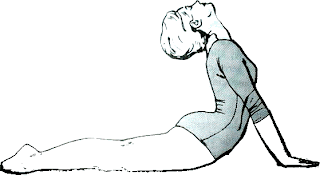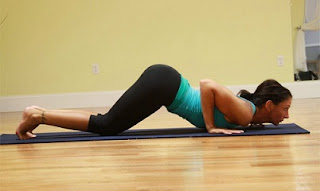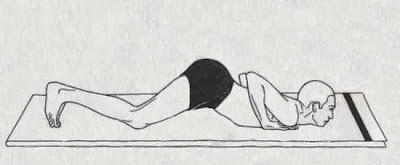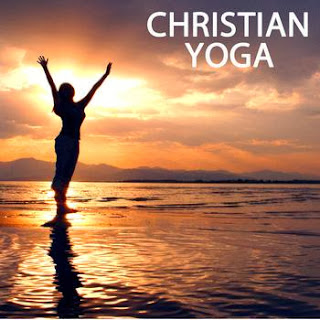Wednesday, December 25, 2013
Points To Be Followed Before Learning Yoga
Saturday, December 14, 2013
Yoga With Balance Ball?
What is A Swiss Ball?
A Swiss ball is a ball constructed of elastic rubber with a diameter of around 55 to 85 cm (22 to 34 inches). It is used in physical therapy and exercise.
Thursday, December 12, 2013
Yoga Your Way to Physical and Mental Fitness
Isn't It Time To Try Kundalini Yoga?
Wednesday, December 11, 2013
How to find the right Yoga teacher?
I am often asked by beginners about how to evaluate a Yoga Teacher?
The following is the “CALM check list.” These factors are basic criteria that your Yoga Instructor should meet before you continue on to a second Yoga class.
Tuesday, December 10, 2013
Building stronger arms through Yoga
Being that he does this rather frequently, I asked why and his response was
“Oh, my yoga classes don’t do anything for my arms.”
Benefits Of Pincha Mayurasana
Saturday, December 7, 2013
Beginners Yoga Class Satyananda Style
Beginners Yoga Class Satyananda Style
You will get new energy and a positive mindset with this gentle Beginners Yoga ClassBenefits Of Performing - Standing Head To Knee Yoga Pose
Friday, December 6, 2013
Weight loss Safely with Yoga for Beginners
Weight loss Safely with Yoga for Beginners
"Weight loss for Yoga Beginners" Is an interesting sequence to become more fit and lose some weight. Do this yoga sequence 3/4 times a week. Remember to drink lots of water andeat moderately and healthy.
[Yoga Video] Yoga for Complete Beginners - Yoga Class 20 Minutes
[Yoga Video] Yoga for Complete Beginners - Yoga Class 20 Minutes
Benefits of 20 different types of yoga for your Health
Yoga is thought to date back to atleast 3000BC and has been practiced in India to promote physical, mental and spiritual health for millennia. The first text on classical Yoga was written by a legendary Yogi called Patanjali. His path towards self-knowledge is known as "ASHTANGA YOGA" or eight limbed yoga, as it consists of 8 steps to enlightenment. These steps help to discipline the body, mind, breath, emotions and spirit.
Benefits Of Padangusthasana
Benefits Of Matsyasana
Benefits Of Garudasana
 'Garuda' means eagle and 'asana' means pose. Garuda known as king birds also happen to be the vehicle of Vishnu. Even though most of the yoga poses aims towards balance and tranquility, by the look of the asana it will be more visible. This asana would help in loosening up your joints. Stretching your muscles would help in making all the parts of your body more fit.
'Garuda' means eagle and 'asana' means pose. Garuda known as king birds also happen to be the vehicle of Vishnu. Even though most of the yoga poses aims towards balance and tranquility, by the look of the asana it will be more visible. This asana would help in loosening up your joints. Stretching your muscles would help in making all the parts of your body more fit.Thursday, November 21, 2013
Benefits of Chair Yoga – Part 4
Benefits of Chair Yoga – Part 3
When you consider that mobility for seniors can be the difference between dependence and independence, flexibility is now of extreme value.
Sunday, November 17, 2013
Benefits of Chair Yoga – Part 2
Benefits And Importance Of Adho Mukha Svanasana
Benefiting From Your Yoga Practice
How Yoga Helps You Lose Weight Safely
Benefits of Chair Yoga – Part 1
In comparison to many forms of exercise, the benefits of Chair Yoga far outweigh the risks. The therapeutic exercises work the body, from head to toes, to the best of any client’s ability.
Tuesday, October 29, 2013
Benefits And Usefulness Of Trikanasana
Thursday, October 24, 2013
Benefits And Usefulness Of Dandayamana Bibhaktapada Paschimottanasana
A stiff body becomes very flexible by doing this asana. It helps in improving your basic movements. There is fresh supply of blood to the brain which helps it to stimulate the brain for better functioning. The posture helps in toning your abdominal organs which helps to create a flexible body. A flexible body helps you do this posture in a much better manner. If done properly the benefits you reap will remain with you life long.
It is very important that you keep your legs straight while doing this asana. The inhaling and exhaling at the right time also creates a favorable impact on your body. It is very good for clearing your mind to get you out of depression. Many of the ailments related to stomach can be bid adieu. It helps in relieving constipation, indigestion and acidity. It compresses the pancreas which helps in maintaining your diabetes level. The asana helps in reverting your age as your face glows by doing this asana.
Sciatica is also prevented as it helps in building and strengthening of the nerves. The sciatic nerves are stretched helping you to recover faster. Your legs are stretched which helps them to get into the proper shape. The legs become much stronger after doing this asana. If you are having weight problems it can help in creating a proper waist line. A good massage is provided to your kidneys, digestive and reproductive system. It is very good for avoiding brain problems such as aneurysms and tumors. It is very good for your back too.
Warning: The reader of this article should exercise all precautions before following any of the asanas from this article and the site. To avoid any problems while doing the asanas, it is advised that you consult a doctor and a yoga instructor. The responsibility lies solely with the reader and not with the site or the writer.
Wednesday, October 23, 2013
Benefits And Importance Of Bhujangasana
Inhaling and exhaling plays a very important part in this or any other asanas. Bending and stretching of your back may differ between individuals. As some has their youth to help whereas some manage even without that. It all depends on how flexible your body is and how much can you bend, to make the utmost use from your asana.
It has been said that, as long as your back is flexible you still have a long way to go. Every muscle of your body is pulled and stretched which gives the elasticity and suppleness to your backbone. With the passing of age our back starts throwing tantrums and becomes very stiff against our wishes. Before any such thing happens tone your body and other parts of your body by doing this asana.
By stretching, it tones the spinal column which reflects your back and with the extra pull entire abdominal muscles get toned too. Torpid muscles like uterine muscles and ovaries get toned too while doing this asana. It is one of the best asana which serves as a medicine for wet-dreams and leucorrhoea. It also helps in developing your chest as well as firming the bust due to the raising hood position.
This position helps in creating the necessary pressure to the adrenal glands which provides rich supply of blood for the entire body. Liver and other organs next to it also benefits from this asana. Problems of irregular menstrual cycles can be solved with this asana. The pressure applied on your stomach and muscles helps in relieving you from constipation problems. Acute gas troubles are also resolved if the asana is done on a regular basis. People suffering from slip disc problem gain due to the stretching of spinal column giving it a proper toning. Your backache problems may just leave you forever if you do this continuously.
Benefits And Importance Of Ashtanga Namaskar - Part III
7. Bhujangasana (Cobra pose)
Inhale - Om Hiranayagarbhaaya Namah
Benefits: This asana is very useful to keep your back in the fittest position. The spinal region becomes strong and very agile. This asana helps in creating a healthy circulation for your back. It tones your body as well as the spinal nerves. Your digestion is improved. It tones your liver as well as massages the kidneys. The male and female reproductive system improves. Irregular menstrual cycle problems are rectified too. With the increasing blood circulation your face gives a radiant look.
8. Parvatasana
Exhale - Om Mareechibhyoh Namaha
Benefits: This asana is the same asana you do in the No.5 position i.e Parvatasana. Like a mountain it helps in strengthening your arms and shoulders. Your back gets toned due to the elongation of the spine. This is a very good asana for people with bulging bellies as well as increasing waist-line. Any problem with the abdomen is also improved.
9. Ashwa-sanchalan-asana
Inhale -Om Adityaaya Namaha
This asana is the same asana you do in the No.4 position i.e Ashwa-sanchalan-asana. This pose is very useful for massaging your internal organs for better functionality. Your leg muscles are strengthened creating a proper balance. It affects your mind too as it helps it to remain calm and stable. Throat problems can be erased by regular exercise.
10. Pada Hastana
Exhale - Om Savitre Namaha
Benefits: This asana is the same asana you do in the No.3 position i.e Pada Hastana . Having problems with your feet or finger? This asana helps you correct it quickly. Your stomach and your digestive system are free from any complication. The bending of your torso helps your chest to broaden. Arms and hands become stronger too.
11. Hasta Uttanasana
Inhale - Om Arkaaya Namaha
Benefits: This asana is the same asana you do in the No.2 position i.e Hasta Uttanasana. The lifting and stretching of the arms helps the muscles in your arms. Your shoulder becomes strong and flexible. Your digestion improves as it tones the lungs while stretching. It is a good remedy to remove excess weight. This improves your vision tremendously.
12. Pranamasana
Exhale - Om Bhaaskaraaya Namah
Benefits: This asana is the same asana you do in the No.1 position i.e Pranamasana. This position clams your nerves as it eases your body and lets you have a sense of balance.
Ashtanga Namaskar asana ends with the same asana as we had started with i.e Pranamasana.
Warning: The reader of this article should exercise all precautions while attempting to perform any of the asanas. If you are suffering from any health problems consult your doctor and your yoga instructor before trying the asanas. The responsibility lies with the reader and not with the site or the writer.
Benefits And Importance Of Ashtanga Namaskar - Part II
These are the six pose we will try to know about
1. Pranamasana (prayer pose)
Normal Breathing - Om Mitraaya NamahaBenefits: Many of your waist and skin problems would be rectified by doing this asana as it adds passion and vigor to your pose which also helps your legs. Mind achieves control due to the standing pose. It helps in developing distinct personality due to the meditation techniques. Calmness surrounds you which will grant you that level of balance within yourself.
2. Hasta Uttanasana (Arch your back)
Inhale-Om Ravaye NamahaBenefits: This Arch back position helps in your digestion due to the toning of the abdominal organs. In the abdominal organs it tones the lungs as well as the spinal nerves. This is very good for people who are overweight as it helps in reducing that excess baggage you happen to carry everyday.
3. Pada Hastasana (Toe touch)
Exhale - Om Suryaaya Namaha Benefits: If you are suffering from any abdominal problems this is one of the best ways to escape from it. It is a very simple solution to such a problem. It also helps you to remain flexible as it helps to tone your body because it makes your spine supple helping your back get toned properly too. Any problems with your feet and fingers are also corrected.
4. Ashwa-sanchalan-asan - (Horse pose)
Inhale -Om Bhaanve NamahaBenefits: The process of this pose helps in stretching each and every muscle of your body which helps in the proper functioning of your body. Problems like constipation can also be resolved. As there is stretch on the neck muscles it helps with your thyroid glands.
5. Parvatasana - (Downward facing dog pose or Mountain pose)
Exhale -Om khagaaya NamahaBenefits: This asana helps in creating a strong set of arms and shoulders. The muscles are also strengthened which in return tones the spinal nerves for a flexible back. In the modern times you will find more and more obese people interested in learning yoga. This asana is good to reduce your bulging waist line, which tends to be the main problem for many.
6. Ashtanga Namaskar - (Push-up pose)
Hold breath -Om Pooshney NamahaBenefits: This pose is known as the salute to the sun with eight parts of your body. Your hands, legs, chest and feet work in synchronization to provide the actual benefit for your body. It helps in developing your chest muscles as it is also known as the push-up pose.
Tuesday, October 22, 2013
Benefits And Importance Of Ashtanga Namaskar - Part I
This asana is also known as Surya Namaskar Asana or Sun Salutation Asana. It is a combination of 12 postures and each posture provides its unique benefits. The essence of this asana is salutation of the Sun god, which is power source of all the energy in this world. So in process to salute the sun god it also helps our body. This asana becomes very important due to the valuable part it plays with our lives. The composition of these poses in its own different way helps in creating a fit and fine body for you.
In a gym, a cardio would include aerobics, skipping, and running, jogging and cycling. By doing Ashtanga Namaskar you will be able to derive all the benefits you try to obtain by going to the gym. When you look at the flipside gym would turn out to be more expensive in comparison to your yoga pose.
It readily flexes your body by providing one of the greatest massages to your each and every curve in your body. In the process of internal massaging it also works out externally. Your body becomes the incubation ground for generating power source to your body. It also helps in the purification process of your body.
It becomes very beneficial to the heart and as it tones it immensely to help the cardiac muscles and arteries. Every step of this asana turns out to be one beautiful gift for your body. The synchronized way of breathing helps you to push out those toxins which are harmful for your body. The 12 poses have to be done in a specific manner. It includes a process of inhaling and exhaling which has to be followed strictly. Along with the poses you can chant some of the Mantras which may help to create synergy in your body.
The meditating mind creates awareness about the existence of the world. Your mind overflows with confidence which you be lacking for a very long time. The mind and body works together to help your soul to lighten up, which is very easily shown on your radiating face.
This exercise is not only about being physically fit but about creating an understanding about the inner chakras. It is the concentration level which helps this pose to attain its success. The particular mantra which is chanted along with the pose helps in creating that sense of concentration.
This is an elaborate asana and doing this would need lot of practice. So people who have good stamina, with no health problems like blood pressure, heart disease, hernia, intestinal tuberculosis and many other problems can do this pose. So anyone attempting the asana should consult your doctor and your yoga instructor.
Benefits And Importance Of Adho Mukha Vrksasana
 To make it easier it would be better for you to take support of a wall, helping you to overcome your fear of falling while doing this asana. There a...
To make it easier it would be better for you to take support of a wall, helping you to overcome your fear of falling while doing this asana. There a...Vrksasana is a tree pose which means you are standing with your hand raised towards the sky. Adho Mukha Vrksasana can be termed as a tilted tree pose where in your hands are supporting the entire body weight. This asana when done by beginners has to be done very carefully as balancing yourself on your hand cannot be that easy.
To make it easier it would be better for you to take support of a wall, helping you to overcome your fear of falling while doing this asana. There are many benefits for doing this asana as this helps in strengthening every part of your body helping you to create a more stable and calm body. Your shoulders and arms get stretched and in that process all the bones in your body also gets a good massage. Practicing this asana along with some teacher or friend would help you to do this asana without much hassle.
Even though this asana is very difficult but once you master it, the benefits you reap from this asana would be of great help. It can help each and every part of your body making them fit and fine for a better and healthier life. While doing this asana in the beginning you can use a padding which would support your handstand. Your hands won't feel the direct coldness from the floor and would help in doing the asana properly. This stabilizes your pose and avoids the strain.
You can also change your hand position to improve your handstand. You can keep your hands either outward which will also be a key ingredient to help you. Use of props and by modifying this asana you can get full benefits without creating too much strain on yourself.
There is fresh supply of blood due to this tilted pose. It stretched your arms, muscles, shoulder and wrists making it more flexible and agile. This asana tests your strength and also at the same time helps in increasing your stamina. This balancing act helps you remain calm and cool due to the stability it provides. A sense of balance is achieved in your mind as well as your soul. There is a calming effect overall in your mind which helps the brain to relax.
You should take extra care of your back and shoulders while doing this asana. There are chances of neck injury and other problems if it is not done properly. Your spine, lungs and pituitary glands are also benefited in this process. With the straight back your spine also gets straightened which helps immensely in the long run.
Monday, October 21, 2013
Five Fantastic Ways To Get Rid Of Stress
Feeling overburdened and tired are sure signs of stress. Stress can also show when your body begins to drag by with a lot of pains and aches. This is attributed to the fact that you may be overworked. It is very dangerous to have stress and do nothing about it. With time, stress can translate into something bigger like depression. It can even result into high blood pressure. This is why you should deal with it immediately you fall victim to it.
How to handle stressful situations
Do not allow yourself to be victimized by stressful situations. After a while, the buildups will cause you to explode and it will not be a pretty sight. When stress builds up, it leaves someone feeling grumpy and easily irritable. To prevent this, you have to be able to stop the stress when it first resents itself. If you are wondering how you can drive away stress, here are a couple of simple ideas that you can use;
1. Disengage
When you are immediately faced with a stressful situation, detach yourself from it. You could walk away or ask to leave. If you were in a meeting, come up with an important excuse and leave even if just for a few minutes so you can cool down.
2. Music
Listening to music can help you get rid of all the tension building up in your head. Music normally acts like a distraction and will shift your thought process. You will also find the beats of the song and particular words very applicable to your life.
3. Let it out
Find someone close to you and talk your stress out. Make sure that this is someone who has you best interest at heart and is close to you. Not only will your confidant be able to help you release your tension, they can also give you advice.
4. Take a break
Stop doing what you normally do and take a break. You can go for spa treatment or go do some yoga. Once you allow yourself to be in the hands of a qualified instructor who has gone through the best yoga teacher training, you can rest assured that you will feel relaxed in no time.
5. Sleep
Even after taking some time off to visit a yoga paradise, you need to get your entire body may be a little tense. This is why you need some shuteye. Your body must be allowed to rest so that it can release stress. Sleeping is the best way to relax your body and mind.
Thursday, October 17, 2013
Benefit of Yoga Part I
The practice of Yoga brings with it many physical and emotional benefits that the majority of people are unaware of. This article is quite long, so we have broken it up into two parts. The first part is an introduction to Yoga and a overview of the major physical and psychological benefits of Yoga, while the second part shows how practicing yoga daily can have a profound effect on your ability to create a healthy lifestyle for yourself.
Yoga is a science; and indeed, in many places in the world (such as India), it is referred to as a science. This is not merely playing with words; it truly is approached as a science, which means that it is understood in terms of scientific methods.
Yogic science seeks to verify cause and effect, and build principles based upon objective observations. Indeed, in many places in the world, to be a yogic master of any credibility, one must be highly educated in the sciences, including physics and the biological sciences.
This discussion on yoga as science is important for us to include because it allows us to sensibly ask the question: what are the benefits of yoga? After all, if yoga is a faith or a belief, then asking this question isn't fair; because it's one that yoga cannot answer in terms that we can objectively understand.
Yoga is a science; as empirical and pragmatic as kinesiology, or exercise science, which seeks to understand how the body acts and reacts to changes in the internal physical environment. And even more simply than any of this: each of us has a right to ask the basic question, "why should I bother practicing yoga and what experience or benefits can I expect?"
Indeed, while the experience of yoga cannot be reduced to words – just as reading a book on preparing for a marathon isn't going to actually physically prepare you to run a marathon – the goals and principles of yoga can easily be discussed.
Here's the Mayo Clinic's take on the benefits of meditation:
"Meditation is used by people who are perfectly healthy as a means of stress reduction. But if you have a medical condition that's worsened by stress, you might find the practice valuable in reducing the stress-related effects of allergies, asthma, chronic pain and arthritis, among others."
Yoga involves a series of postures, during which you pay special attention to your breathing — exhaling during certain movements and inhaling with others. You can approach yoga as a way to promote physical flexibility, strength and endurance or as a way to enhance your spirituality.
The Mind-Body Connection
Yoga is centered on the mind-body connection. This mind-body harmony is achieved through three things:
- postures (asanas)
- proper breathing (pranayama)
- meditation
Mind and body draw inspiration and guidance from the combined practices of asanas, breathing, and meditation. As people age (to yogis, ageing is an artificial condition), our bodies become susceptible to toxins and poisons (caused by environmental and poor dietary factors).
Yoga helps us through a cleaning process, turning our bodies into a well synchronized and well-oiled piece of machinery.
Physical Benefits
By harmonizing these three principles, the benefits of yoga are attained. And just what are these benefits?
- equilibrium in the body’s central nervous system
- decrease in pulse
- respiratory and blood pressure rates
- cardiovascular efficiency
- gastrointestinal system stabilization
- increased breath-holding time
- improved dexterity skills.
- Improved balance
- Improved depth perception
- Improved memory
Psychological Benefits
As noted above, Yoga also delivers an array of psychological benefits; and in fact, this is a very common reason why people begin practicing it in the first place. Perhaps the most frequently mentioned psychological benefit of yoga is an improved ability to manage stress. Yoga diminishes an individual’s levels of anxiety, depression, and lethargy; thus enabling him/her to focus on what’s spiritual and important: achieving balance and happiness.
In part II of the Benefit of Yoga we'll reveal how yoga can help deal with stress, unhealthy habits and pain management. The benefits of Yoga go far beyond meditation and stretching, it is a way to release those toxic emotions that tend to stand in the way of living a healthy life.
Wednesday, October 16, 2013
Benefit of Yoga - The Christian Viewpoint
The benefit of yoga is twofold - increased health and unification of the spirit with the body. It is accomplished through the use of many different aspects, but mainly through the combination of Asanas, or postures, and breathing/meditation practices.
This raises many question in the Christian community. In my research for this article, I was very surprised at the viewpoint of the Christian apologists, and their take on yoga and its practice. I have hesitated on writing this article because of that viewpoint. However, I feel that this question and the stance of the Christian community warrants reflection on the subject.
Yoga has a history dating back over five thousand years, to the beginning of the civilization of man. Little is really known about Yoga. it is believed to have originated in Mehrgarh, a neolithic settlement in what is now Afghanistan. Scholars believe it has grown out of Stone Age Shamanism. In this early period of civilization's beginnings, Yoga was a community resource, because of its attempts to determine cosmic order through inner vision, and apply it to daily living. In later years, yoga evolved into an inner dialogue through which the Yogis sought to develop their own salvation and enlightenment.
Archaeological evidence of the existence of Yoga first appeared in stone seals excavated from the Indus valley. It depicted figures in many Yogic Asanas, or postures, and officially put Yoga in the time period of approximately 3000 B.C. Of greater import, it also linked yoga to the great Indus-Sarasvati Civilization, a period in time that was considered modern and efficient.
From the Indus-Sarasvati civilization came the ancient texts known as the Vedas, the oldest scriptures in the world. The Vedas are a collection of hymns that praise a higher power and contains the oldest recorded history of Yoga teachings. The Vedas required the practitioner to transcend human limitations, and reach a higher spiritual plane. In later years, texts known as the Brahmanas were written to explain the rituals and the hymns of the Vedas. Following this came the Aranyakas texts, which outlined the practice of Yogis living in the seclusion of the forest. This led to the beginning of India's medical tradition, known as Ayurveda. All in all, Yoga transformed into a practice of health, harmony of the spirit, and a way of life.
The Christian viewpoint is thus - if one opens the mind to clearer thinking and inner vision, they open the spirit to demonic possession. It is felt that Yoga practice borders on occultism, and that opening one's mind and spirit to the benefit of yoga is both dangerous and against everything Christianity preaches. Christians believe that studying yoga is akin to practicing Hinduism, and one cannot separate the philosophy of Hinduism from their Christian beliefs, regardless of the health benefit of yoga.
As a practicing Buddhist, I take issue with this viewpoint. To me, this smacks of tunnel vision and narrowmindedness. A Christian is expected to open their heart and minds to Jesus, and to give in to the spirit of the Lord. They are expected to rely on blind faith, and to accept the word of God as the only truth in the world. A thinking person would find this hypocritical, for on the one hand Christians preach that Yoga must be avoided because opening the mind to clearer vision encourages the possibility of demonic possession, yet on the other hand preaches that one must open the mind and heart to accept Jesus into their lives. Opening one's heart and mind is exactly that - whether it is to look into one's self, or to accept Jesus into their lives. If, as Christians preach, we are open to demonic possession if we look inside ourselves and open the mind to all the possibilities, how then can we safely open our hearts to the concept of Christianity? Is there a gatekeeper who makes this decision when we do so that determines what path we are to follow? I think not...
For the record, I was raised in a Christian household. My father was the deacon of a small Baptist church in the farming community where we lived. My mother, who taught us children to question everything, moved from the Baptist community to the Assembly of God churches, and was ostracized by my father. I think that to her dying day, she resented my father for this narrowmindedness. Life is a matter of choice, and my mother believed that we are not required to operate under the illusion of blind faith, but to do what is right to us as an individual. And it is why I walk the Noble 8 Folded Path. It is simply a matter of choice, and questioning everything in this universe.
I believe that the practice of yoga is a good thing. It provides us with great health benefits, clearer vision, and harmony in our souls. And in this day and age, what else is there? Whether we be Christians, Muslims, or Buddhists, we must not disrespect the feelings and thoughts of others, their rights to practice as they wish, or try to push our views down other people's throats. To live in harmony is exactly that...
To find out more about the benefit of yoga, visit my website at http://yogaforthepeoples.blogspot.com/
Friday, October 11, 2013
Baddha Konasana – A Great Asana For Hip And Groin
Baddha Konasana (Bound Angle Pose) is also known as the Cobbler's Pose because of the similarity to a cobblers sitting position. It is an excellent asana which helps your groin and hip position. It is a forward bending asana which starts off from Staff Pose or Dandasana. You have to bend your knees by bringing the soles of the feet together. This forward bending asana is very different to the other forward bending asanas. The focus area in this asana is to open the hip and help the pelvic area. This help to the pelvic area stimulates the reproductive organs which are of great help to women as well as men. The performance of this asana also helps in alleviating the menstrual pain problems. It is very useful to have a comfortable child birth, if practiced regularly during the period of pregnancy. Also clears menopause related problems.
Baddha Konasana stimulates the abdominal organs as well as the ovaries, prostate gland, bladder and kidneys. It energizes your heart which improves the blood circulation and provides the all needed help to your body. This asana stretches the inner thigh, groin and knees which gives your body an agile and toned look. If you have problems like depression or anxiety this asana can help you overcome that problem. People with sciatica problem can also be treated by performing this asana regularly. It is a great asana because of its tremendous benefits for our aching and paining body. Known to be a therapeutic treatment for flat feet and similar other problems to be dealt by this asana. The practice of Baddha Konasana prevents the attack of many other diseases.
The forward bending asana helps in opening the back of the Anahata chakra. It can be greatly used for back pain problems. This asana should either be done in the beginning to open up the hips or at the end to relax your body. You should avoid doing this asana if you have a groin or knee injury. It is very important to perform this asana while sitting on a blanket as it gives support to your thighs. This asana is very important if it is done properly and enough time is given on every step. This is a very hard pose to manage on your own; maybe you should take help from your yoga teacher or a partner. You can make this pose much deeper by adding variations to it. The can be done by stretching their arms out in the front with the palms on the floor and forehead placed on the ground by extending the spine.
- Alternate Your Strength Training Workout With Some...
- Anuloma-Viloma - Yogic Breathing For Better Health...
Warning: The reader of this article should exercise all precautions before following any of the asanas from this article and the site. To avoid any problems while doing the asanas, it is advised that you consult a doctor and a yoga instructor. The responsibility lies solely with the reader and not with the site or the writer.
Thursday, October 10, 2013
Ashtanga Yoga - Is it right for you?
Ashtanga Yoga is the type of yoga which was urbanized and founded by K. Pattabhi Jois. This kind of yoga is known as the Eight Limb Yoga which has revolved in Pattanjali's massive idea. It presented that the path of purification is made up of the eight spiritual practices.
The first four limbs that represent Ashtanga Yoga are - yama, niyama, Asana and the Pranayama. These are considered cleansing practices which are externally correctable. The other set of limbs which are the - pratyahara, dhyana, dharana are the internal practices.
These limbs can only be corrected by the appropriate application of the Ashtanga Yoga method. This type of yoga method is quite dangerous to the mind.
K. Pattabhi Jois said that practicing these Eight Limbs and also its sub-limbs of the external practices which include the niyama and yama is not possible. In doing so, the body should be strong enough so that it can perform the practices. If the body is weak, and the sense organs are not functioning well, practicing will never be useful to the person at all.
The philosophy which K. Pattabhi Jois has applied is that you must keep in mind that after doing this Ashtanga Yoga the body will improve and it will be stronger and healthier.
Vinsaya and Tristhana are practiced in Ashtanga Yoga.
The Vinsaya is a style that makes Ashtanga and its principles discrete from the others. Vinsaya means the movement and breathing which is used for the internal cleansing process. Each movement done is accompanied by only one breath. Sweat is the most important product of Vinsaya. When you produce sweat, it only means that you are successfully applying the practice. When you perform the Asanas, the body creates heat which causes your blood to boil and excrete the toxins outside of your body. The toxins are found in your sweat. So the more sweat you create, the more toxins are released.
These yoga poses are used to fully develop the strength and health of the body. The series of practices make this possible. There are three postures used in Ashtanga Yoga.
The three are classified on different levels.
The first is the Primary Series which aims on aligning the body and also detoxifying it.
The second is the Intermediate Series opening and cleaning the energy channels which comes to the process of purifying the Nervous System.
The last series would be the Advanced Series from A to D. in this series, the grace and strength is measured.
The Tristhana is another yoga principle which represents the union of the three places of action and attention. First is the posture, second is the breathing technique ad last is the Dristhi of the Looking Place. All these three should work altogether to perform a function.
Breathing techniques are simultaneous and synchronized. It is important to make a single breath for one movement. Ujjayi Breathing is the Yoga Breathing Technique used in the application of Ashtanga Yoga. Applying this technique must be prolonged after every practice. What you need to master is holding your pose longer at the same time hold your breath. This is an amazing breathing exercise that will increase your internal fire and will strengthen the Nervous System.
And you thought Yoga Was Just Stretching | Yoga Li...
7 Best Important Tips for Yoga Success
Setting the mind clear and cleansing it can only be done in the Eight-Limb Yoga or Ashtanga Yoga.
Wednesday, October 9, 2013
Ardha Kurmasana - Half Tortoise Pose
The shoulder movement gets improved and so does the muscles in the corresponding areas. The abdominal muscles...
Ardha Kurmasana is also known as Half Tortoise Yoga Asana. Due to its resemblance to a tortoise it is known as the tortoise pose. This yoga asana can prove to be very beneficial to your body in every possible way. By performing this asana regularly and properly our bodies can be rejuvenated. The organs get stretched to its maximum with every movement of this asana.
The shoulder movement gets improved and so does the muscles in the corresponding areas. The abdominal muscles gets toned and become more flexible. The asana stretches the lower part of the lungs which is good for your breathing. It also increases the lung capacity which proves to be crucial if you have breathing problems like asthma. The pressure put on your neck and head improves migraine problems. It can be stated as a stress buster due to its stress relieving capacity.
Stomach related problems are solved too. If you suffer from indigestion or constipation this asana helps to improve it greatly. The digestive system is up and running with the help of the asana. Fresh supply of blood is provided to each and every organ for a smooth flowing bodily system. It relaxes the brain by the fresh supply of blood. Many of your sleeping problems are addressed by performing this asana. It is a good cure for insomnia.
Backache problems can termed as a thing of past. Ardha Kurmasana stretches the spine which relieves you from any backache or spine problems. Due to the level of blood circulation, your heart remains fit and fine. The bending and stretching increases the level of flexibility of your arms and hips. Toning gives great shape to your body which keeps you positive and healthy.
The internal organs are massaged very well to bring the extra zest needed for your body. It serves as a great remedy for anemic as well as diabetic patients. The pressure on the thigh and legs makes it strong and sturdy. It also tones the thigh muscles due to the position in which the asana is done. The spine is elongated by the stretch provided during the asana. It is a benefit in disguise, as it cures many ailments.
Warning: The reader of this article should exercise all precautions before following any of the asanas from this article and the site. To avoid any problems while doing the asanas, it is advised that you consult a doctor and a yoga instructor. The responsibility lies solely with the reader and not with the site or the writer.
Tuesday, October 8, 2013
Alternate Your Strength Training Workout With Some Yoga
The avera...
Many who think of strength training equipment think of the massive muscles that many bodybuilders get and consequently show off in competitions. This can be a plus or a drawback for many consumers. The average consumer likes to be able to say feel good about themselves when they go swimming, but many are concerned about building too much muscle and suffering from stereotypical viewpoints. This needn’t be a worry for anyone considering strength training equipment.
The average body builder works out a lot in order to get the muscles they are famous for, plus they have to be on a very strict regimen with lots of protein and little or no fat. It would take you a lot of effort to become as built as the average bodybuilder. Many consumers can use simple free weights in order to maintain the muscle mass that they have or to add a little muscle strength. Some use strength training equipment to add a little tone or shape to certain areas of the body.
If you use them properly and alternate your strength training workout with some yoga or stretching exercises there is little risk of you bulking up too much. Many find that they enjoy the challenge of working out with strength training equipment. You can gradually increase the weight as you work out over a period of time and after your workout you really will feel the ‘burn’ in your muscles.
Though you should be careful of using too much weight at once. Its easy to sprain a muscle and hurt yourself, putting you out of commission for a few days or more. A good rule of thumb is that if you think you can start out with a certain weight begin about five or even ten pounds lighter and after a few repetitions move up to the next weight level. You can check out strength training equipment reviews online for an idea of what others are doing.
Anuloma-Viloma - Yogic Breathing For Better Health | Yoga Living
This is a truism as a healthy body is the prime requisite for success and happiness in life. People are increasingly being convinced that yoga makes for good health, contentment and happiness in present day stressful life and is not just an exercise regimen.
In this article we will discuss Anuloma-Viloma (alternate breathing) pranayama. Pranayama simply means p...
Swami Kuvalyanand once said: “Yoga has a message for the human body, for the human mind and the human spirit.”
This is a truism as a healthy body is the prime requisite for success and happiness in life. People are increasingly being convinced that yoga makes for good health, contentment and happiness in present day stressful life and is not just an exercise regimen.
In this article we will discuss Anuloma-Viloma (alternate breathing) pranayama. Pranayama simply means proper ‘management’ of the vital force - prana. Although the basic principle remains the same, many different types of pranayama have been devised, each with its own unique technique. Anuloma-Viloma or nadi shuddhi pranayama (nerve purifying pranayama) is one such kind and is considered one of the basic forms.
The practice of Anuloma Viloma is somewhat like the squad that regulates traffic on roads, looks after their cleanliness, beautification, etc and keeps the traffic moving smoothly and efficiently. The method involves breathing in (pooraka) through one nostril and vice versa. Therefore this pranayama has the name anuloma viloma, i.e. alternate breathing.
To practice this, you have to sit in any of the yogic sitting postures. To begin with, carry on normal breathing applying moola bandha (i.e. comfortable anal contraction). Keeping a stable moola bandha, breathe in and breathe out completely. Ensure that the moola bandha is not loosened during the process. Pause for a while between breathing in and breathing out. Breathe in deeply through the left nostril and breathe out through the right; then breathe in through the right and out through the left. Continue breathing this way, i.e. alternately from left and right nostrils, for one to three minutes.
After reaching a comfort level in this way, you may move to the next stage. Close the right nostril with the right thumb keeping the other four fingers together. Now, slowly breathe in through the left nostril at a uniform speed. Repeat with the other nostril. While breathing in, raise the shoulders and expand the chest taking the ribs up. The lower abdominal region, however, must be held in.
Benefits: The respiratory passage is cleaned and this prepares one well for the practice of other pranayamas. Breathing becomes easy and regulated. The mind becomes and heartbeat rhythmic. Also aids in enhancing concentration, memory and other mental faculties.
Contraindications: Severe pain in abdomen, swelling on account of appendicitis, enlargement of liver, very delicate bowels or intestines, disorders of the lungs, severe throat infections, growth in the nose (polypus) or blockage of the nasal passage due to cold, etc.
Warning: The reader of this article should exercise all precautions before following any of the asanas from this article and the site. To avoid any problems while doing the asanas, it is advised that you consult a doctor and a yoga instructor. The responsibility lies solely with the reader and not with the site or the writer.
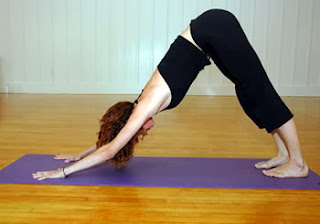



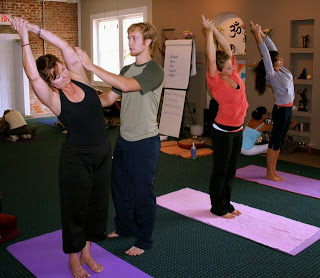


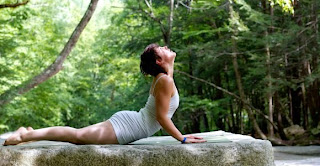

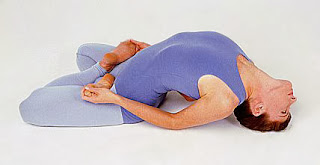
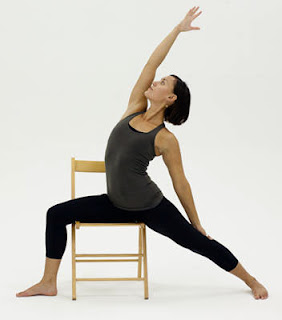

.jpg)

